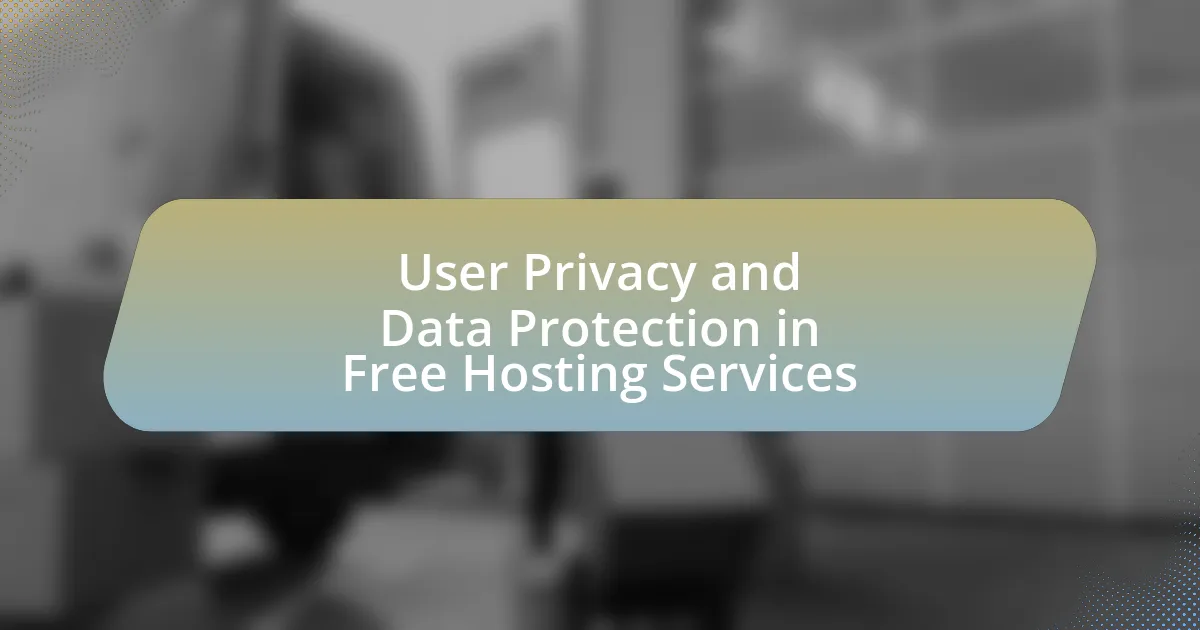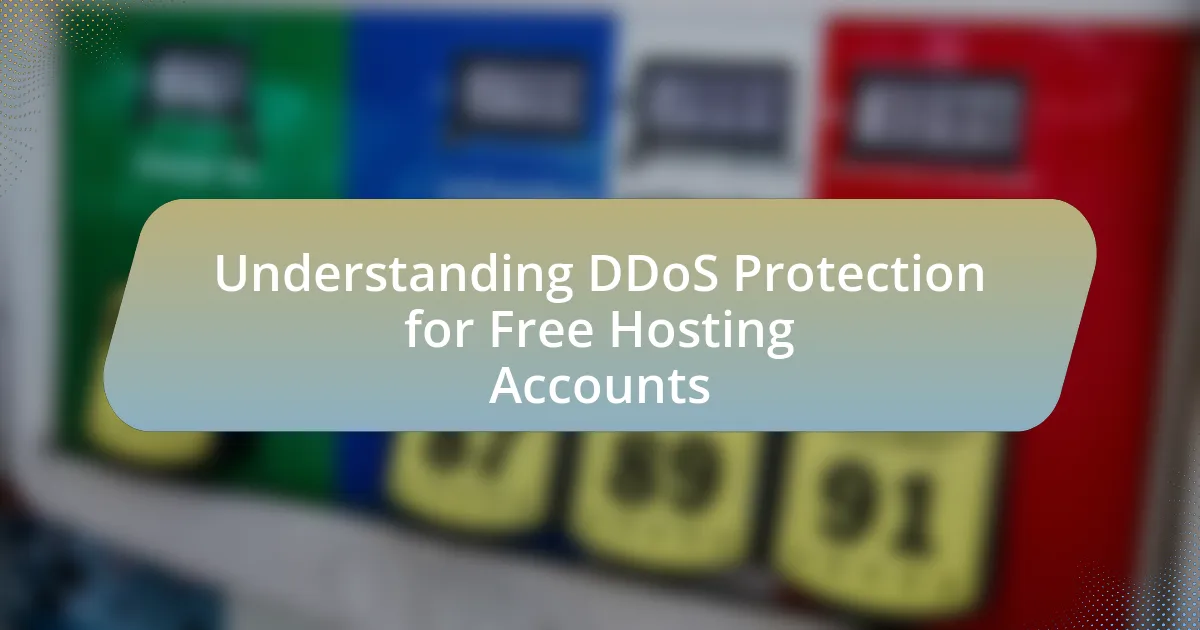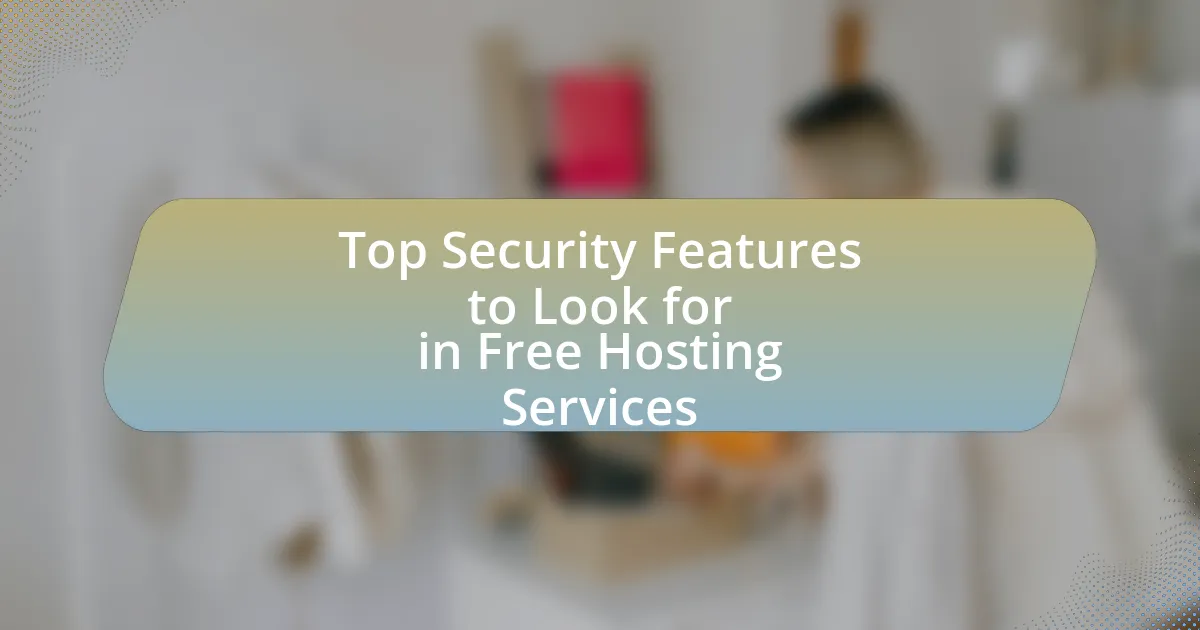The article focuses on best practices for securing websites hosted on free hosting platforms, emphasizing the importance of implementing HTTPS, strong passwords, regular software updates, and security plugins. It outlines key considerations such as the differences in security features among free hosting services, common vulnerabilities, and the impact of limited resources on security. Additionally, the article discusses the risks posed to both website owners and visitors by unsecured sites, and it provides actionable strategies for enhancing security, including the use of SSL certificates and effective backup practices. Overall, it serves as a comprehensive guide for users seeking to protect their websites from potential threats in a resource-constrained environment.

What are the key considerations for securing a website on free hosting platforms?
Key considerations for securing a website on free hosting platforms include using HTTPS, implementing strong passwords, regularly updating software, and utilizing security plugins. HTTPS encrypts data between the user and the server, protecting sensitive information from interception. Strong passwords prevent unauthorized access; a study by Verizon found that 81% of data breaches are due to weak passwords. Regular software updates patch vulnerabilities that could be exploited by attackers. Security plugins can provide additional layers of protection, such as firewalls and malware scanning, which are crucial on platforms that may lack robust security measures.
How do free hosting platforms differ in terms of security features?
Free hosting platforms differ significantly in their security features, primarily in the level of encryption, data protection, and support for security protocols. For instance, some platforms may offer basic SSL certificates, while others provide advanced security measures like DDoS protection and regular security audits. According to a study by HostingAdvice, only 30% of free hosting services include SSL encryption, which is essential for securing data transmission. Additionally, many free hosting providers lack robust backup solutions, leaving user data vulnerable to loss or breaches. This disparity in security features can greatly impact the safety of websites hosted on these platforms.
What common vulnerabilities exist on free hosting platforms?
Common vulnerabilities on free hosting platforms include inadequate security measures, lack of regular updates, and shared resources that can lead to cross-site scripting (XSS) and SQL injection attacks. Inadequate security measures often result from limited resources allocated to security protocols, making these platforms attractive targets for cybercriminals. The absence of regular updates can leave software exposed to known vulnerabilities, as many free hosting services do not prioritize timely patching. Additionally, shared resources can create opportunities for attackers to exploit vulnerabilities in one site to compromise others on the same server, as evidenced by numerous reports of cross-site scripting and SQL injection incidents in shared hosting environments.
How can the lack of resources on free hosting platforms impact security?
The lack of resources on free hosting platforms can significantly impact security by limiting the availability of essential security features and support. Free hosting services often do not provide robust security measures such as regular software updates, firewalls, and malware scanning, which are critical for protecting websites from vulnerabilities. For instance, a study by the University of Maryland found that websites lacking regular updates are 2.5 times more likely to be compromised. Additionally, the absence of dedicated technical support can delay the response to security incidents, increasing the risk of data breaches. Therefore, the resource constraints inherent in free hosting platforms directly correlate with heightened security risks for hosted websites.
Why is website security important for users of free hosting platforms?
Website security is crucial for users of free hosting platforms because these platforms often lack robust security measures, making websites vulnerable to attacks. Without adequate security, users risk data breaches, malware infections, and unauthorized access, which can lead to loss of sensitive information and damage to reputation. According to a 2021 report by Cybersecurity Ventures, cybercrime is projected to cost the world $10.5 trillion annually by 2025, highlighting the increasing threat landscape. Therefore, users must prioritize security to protect their websites and personal data from potential threats.
What risks do unsecured websites pose to visitors?
Unsecured websites pose significant risks to visitors, primarily including data theft, malware infections, and phishing attacks. When a website lacks proper security measures, such as HTTPS encryption, sensitive information like passwords and credit card details can be intercepted by malicious actors during transmission. According to a report by Symantec, 1 in 13 web requests leads to malware, highlighting the prevalence of threats on unsecured sites. Additionally, unsecured websites are often used as platforms for phishing, where attackers create fake pages to deceive users into providing personal information. This combination of vulnerabilities makes visiting unsecured websites highly risky for users.
How can a security breach affect the website owner?
A security breach can significantly impact the website owner by compromising sensitive data, leading to financial losses and reputational damage. When a breach occurs, the website owner may face immediate costs related to incident response, such as hiring cybersecurity experts to investigate and mitigate the breach. According to a 2021 report by IBM, the average cost of a data breach is approximately $4.24 million, highlighting the financial implications for affected organizations. Additionally, a breach can result in loss of customer trust, as 81% of consumers stated they would stop doing business with a company after a data breach, according to a survey by KPMG. This erosion of trust can lead to decreased sales and long-term damage to the brand’s reputation. Furthermore, website owners may also encounter legal repercussions, including fines and lawsuits, especially if they fail to comply with data protection regulations such as GDPR or CCPA.
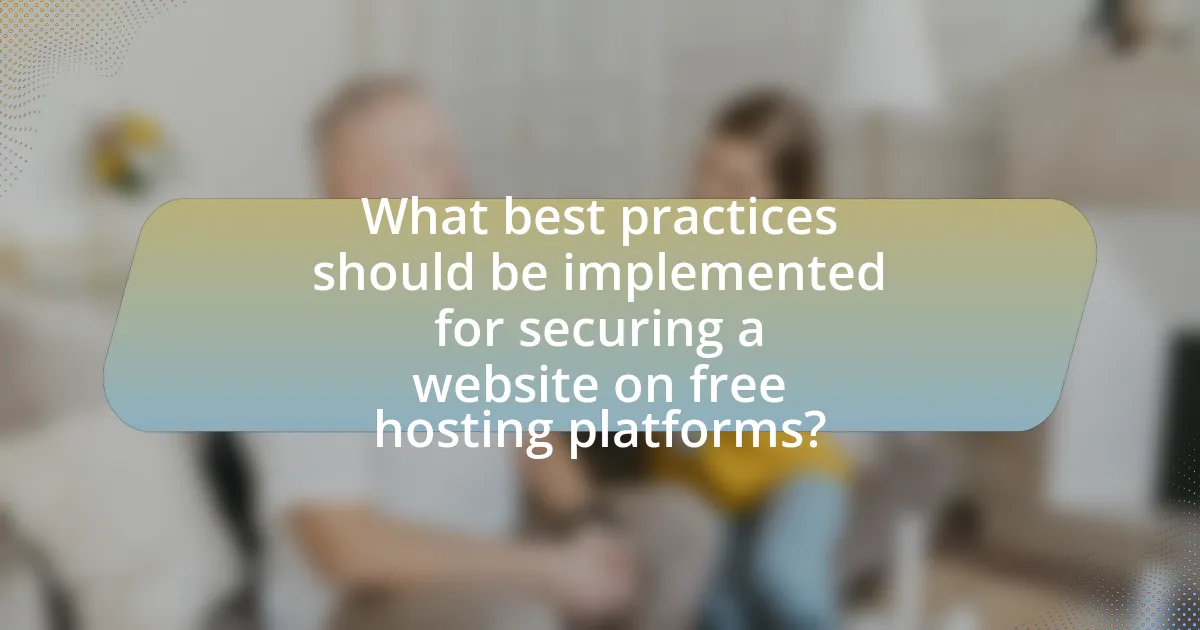
What best practices should be implemented for securing a website on free hosting platforms?
To secure a website on free hosting platforms, implement strong password policies, utilize HTTPS, regularly update software, and employ security plugins. Strong password policies reduce the risk of unauthorized access; for instance, using complex passwords can decrease the likelihood of brute-force attacks. Utilizing HTTPS encrypts data transmitted between the user and the server, protecting sensitive information from interception. Regularly updating software, including content management systems and plugins, addresses vulnerabilities that could be exploited by attackers. Security plugins can provide additional layers of protection, such as firewalls and malware scanning, which are essential for maintaining website integrity. These practices collectively enhance the security posture of websites hosted on free platforms, where resources may be limited.
How can strong passwords enhance website security?
Strong passwords enhance website security by significantly reducing the risk of unauthorized access. A strong password typically includes a combination of uppercase and lowercase letters, numbers, and special characters, making it difficult for attackers to guess or crack through brute force methods. According to a study by the National Institute of Standards and Technology (NIST), using complex passwords can increase the time required for an attacker to gain access, thereby providing a crucial layer of protection for sensitive data and user accounts. Additionally, strong passwords help mitigate risks associated with common attacks, such as dictionary attacks, where attackers use pre-defined lists of common passwords to gain access.
What are the characteristics of a strong password?
A strong password is characterized by its length, complexity, and unpredictability. Specifically, it should be at least 12 characters long, incorporating a mix of uppercase letters, lowercase letters, numbers, and special symbols. This complexity makes it significantly harder for attackers to guess or crack the password using brute force methods. Research indicates that passwords with these characteristics can take years to crack, even with advanced computing power, thereby enhancing security.
How often should passwords be changed for optimal security?
Passwords should be changed every three to six months for optimal security. This frequency helps mitigate the risk of unauthorized access, as it limits the time an attacker can exploit a compromised password. Research from the National Institute of Standards and Technology (NIST) emphasizes that regular password changes, combined with strong password policies, significantly enhance security measures against potential breaches.
What role does regular software updates play in website security?
Regular software updates are crucial for website security as they patch vulnerabilities that could be exploited by attackers. When software developers identify security flaws, they release updates to fix these issues, thereby reducing the risk of unauthorized access or data breaches. For instance, according to a report by the Ponemon Institute, 60% of data breaches are linked to unpatched vulnerabilities. Therefore, consistently applying updates helps maintain a secure environment, protecting sensitive information and ensuring compliance with security standards.
How can outdated software expose a website to threats?
Outdated software can expose a website to threats by leaving it vulnerable to known security exploits. When software is not updated, it lacks the latest security patches that address vulnerabilities, making it an easy target for attackers. For instance, according to a report by the Ponemon Institute, 60% of data breaches are linked to unpatched vulnerabilities. This statistic highlights the critical risk associated with outdated software, as attackers can exploit these weaknesses to gain unauthorized access, inject malware, or compromise sensitive data.
What tools can assist in managing software updates effectively?
Tools that can assist in managing software updates effectively include package managers, automated update tools, and version control systems. Package managers like APT for Debian-based systems and Homebrew for macOS streamline the installation and updating of software packages, ensuring that the latest versions are easily accessible. Automated update tools, such as WSUS for Windows environments and unattended-upgrades for Linux, facilitate the automatic deployment of updates, reducing the risk of vulnerabilities due to outdated software. Version control systems like Git allow developers to track changes and manage software versions systematically, ensuring that updates are applied consistently and can be rolled back if necessary. These tools collectively enhance the efficiency and security of software management processes.
How can SSL certificates improve website security?
SSL certificates improve website security by encrypting data transmitted between the user’s browser and the web server. This encryption protects sensitive information, such as login credentials and payment details, from interception by malicious actors. According to a study by Google, websites using HTTPS (enabled by SSL certificates) are significantly less likely to be compromised compared to those using HTTP. Additionally, SSL certificates help establish trust with users, as browsers display visual indicators, such as a padlock icon, signaling that the connection is secure. This trust can lead to increased user engagement and lower bounce rates, further enhancing the overall security posture of the website.
What is the process for obtaining an SSL certificate on free hosting platforms?
To obtain an SSL certificate on free hosting platforms, users typically need to follow a straightforward process that involves a few key steps. First, users should check if their free hosting provider offers free SSL certificates, as many platforms like Cloudflare or Let’s Encrypt provide this service. Next, users must create an account with the SSL provider if required and generate a Certificate Signing Request (CSR) through their hosting control panel. After generating the CSR, users submit it to the SSL provider to obtain the certificate. Finally, users need to install the SSL certificate on their hosting account, which may involve uploading the certificate files through the hosting control panel or using an automated installation feature provided by the hosting service. This process is validated by the fact that many free hosting platforms have integrated SSL solutions to enhance website security without additional costs.
How does SSL encryption protect user data?
SSL encryption protects user data by establishing a secure, encrypted connection between the user’s browser and the web server. This encryption ensures that any data transmitted, such as personal information or payment details, is encoded and cannot be easily intercepted or read by unauthorized parties. According to the Internet Engineering Task Force (IETF), SSL (now referred to as TLS) uses cryptographic protocols to secure communications over a computer network, making it a critical component in safeguarding sensitive information online.
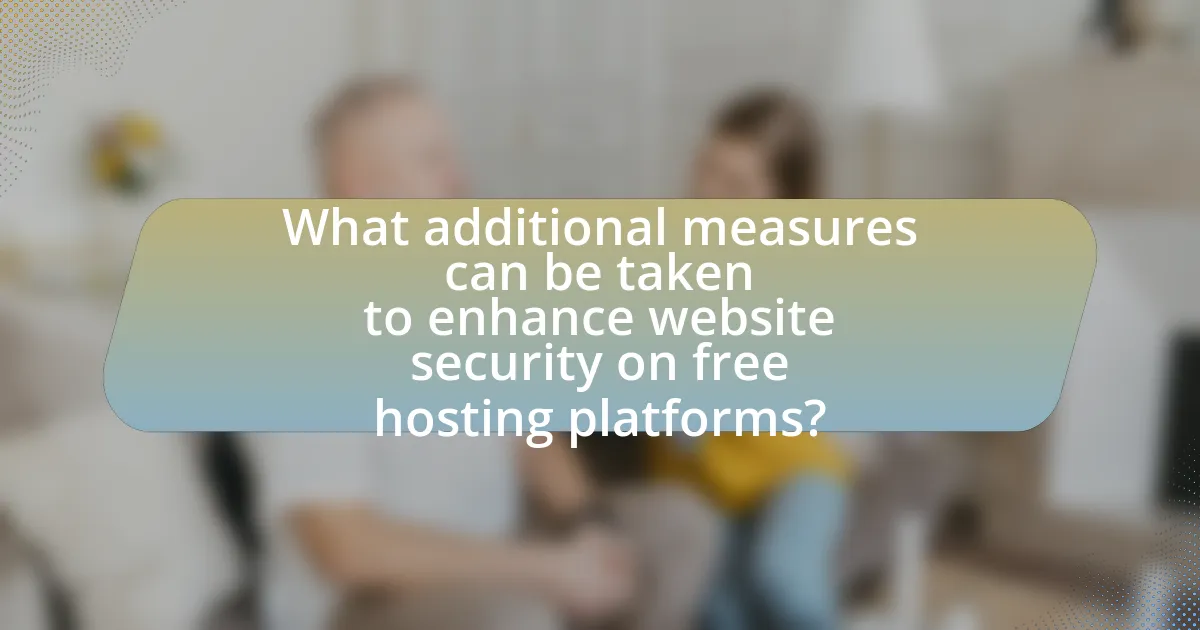
What additional measures can be taken to enhance website security on free hosting platforms?
To enhance website security on free hosting platforms, users should implement HTTPS encryption. This measure protects data transmitted between the user and the website, reducing the risk of interception by malicious actors. According to a 2021 report by the Electronic Frontier Foundation, websites using HTTPS are significantly less likely to be compromised compared to those using HTTP. Additionally, users should regularly update all software, including plugins and themes, to patch vulnerabilities, as outdated software is a common entry point for attacks. Implementing strong, unique passwords and enabling two-factor authentication further secures accounts against unauthorized access. Regularly backing up website data ensures recovery in case of a security breach, providing an essential safety net.
How can website backups protect against data loss?
Website backups protect against data loss by creating copies of website data that can be restored in case of accidental deletion, corruption, or cyberattacks. Regular backups ensure that the most recent version of the website is saved, allowing for quick recovery and minimal downtime. According to a study by the University of Maryland, websites are attacked every 39 seconds on average, highlighting the importance of having a backup strategy in place to mitigate the risks associated with data loss.
What are the best practices for creating website backups?
The best practices for creating website backups include regularly scheduled backups, using automated backup solutions, and storing backups in multiple locations. Regularly scheduled backups ensure that the most recent data is saved, minimizing data loss in case of an incident. Automated backup solutions, such as plugins or services, streamline the process and reduce the risk of human error. Storing backups in multiple locations, such as cloud storage and external hard drives, provides redundancy and protects against data loss from hardware failures or cyberattacks. According to a 2021 survey by Datto, 70% of businesses that experience a significant data loss go out of business within a year, highlighting the critical importance of effective backup practices.
How frequently should backups be performed?
Backups should be performed at least daily for websites on free hosting platforms. This frequency minimizes data loss and ensures that the most recent changes are preserved. According to a study by the University of Maryland, 30% of users experience data loss due to hardware failure or cyberattacks, highlighting the importance of regular backups to mitigate such risks.
What security plugins or tools are recommended for free hosting platforms?
Recommended security plugins for free hosting platforms include Wordfence, Sucuri Security, and iThemes Security. Wordfence offers a firewall and malware scanner, which are essential for protecting websites from threats. Sucuri Security provides monitoring and security hardening features, helping to secure websites against attacks. iThemes Security focuses on preventing unauthorized access and includes features like two-factor authentication. These tools are widely recognized for their effectiveness in enhancing website security on free hosting platforms.
Which plugins provide the best protection against common threats?
Wordfence Security, Sucuri Security, and iThemes Security provide the best protection against common threats for websites on free hosting platforms. Wordfence Security offers a comprehensive firewall and malware scanner, which has been proven to block over 1 billion attacks per month. Sucuri Security specializes in website monitoring and malware removal, with a track record of cleaning over 100,000 infected websites annually. iThemes Security enhances security through features like two-factor authentication and brute force protection, significantly reducing the risk of unauthorized access. These plugins are widely recognized for their effectiveness in safeguarding websites against vulnerabilities and attacks.
How can these tools be configured for maximum effectiveness?
To configure tools for maximum effectiveness in securing a website on free hosting platforms, implement strong password policies, enable two-factor authentication, and regularly update software. Strong password policies reduce the risk of unauthorized access, as studies show that 81% of data breaches are due to weak passwords. Enabling two-factor authentication adds an additional layer of security, making it significantly harder for attackers to gain access even if passwords are compromised. Regularly updating software ensures that vulnerabilities are patched, as outdated software is a common target for cyberattacks. These practices collectively enhance the security posture of websites hosted on free platforms.
What are the common troubleshooting steps for security issues on free hosting platforms?
Common troubleshooting steps for security issues on free hosting platforms include checking for software updates, scanning for malware, reviewing access logs, changing passwords, and enabling two-factor authentication. Regularly updating software ensures that known vulnerabilities are patched, while malware scans help identify and remove malicious code. Access logs provide insights into unauthorized access attempts, prompting necessary security measures. Changing passwords regularly minimizes the risk of unauthorized access, and enabling two-factor authentication adds an additional layer of security. These steps are essential for maintaining the integrity and security of websites hosted on free platforms, which often have limited built-in security features.
How can users identify signs of a security breach?
Users can identify signs of a security breach by monitoring for unusual account activity, unexpected changes to website content, and unauthorized access attempts. Unusual account activity may include login attempts from unfamiliar locations or devices, while unexpected changes can manifest as altered website pages or missing files. Additionally, unauthorized access attempts can be detected through logs that show repeated failed login attempts or alerts from security tools. According to a report by Verizon, 81% of hacking-related breaches involve stolen or weak passwords, highlighting the importance of vigilance in monitoring these signs.
What immediate actions should be taken if a security issue is detected?
Immediately isolate the affected system to prevent further damage or data loss. This action involves disconnecting the system from the network and disabling any compromised accounts. Following isolation, conduct a thorough assessment to identify the nature and extent of the security issue. This assessment should include reviewing logs, identifying vulnerabilities, and determining if sensitive data has been compromised. After assessment, implement necessary patches or updates to fix vulnerabilities and restore security. According to the Cybersecurity & Infrastructure Security Agency (CISA), timely isolation and assessment are critical steps in mitigating the impact of security incidents.



